| |
|

FRIDAY, JULY 11 Ohr Shalom Zamru at the Bay
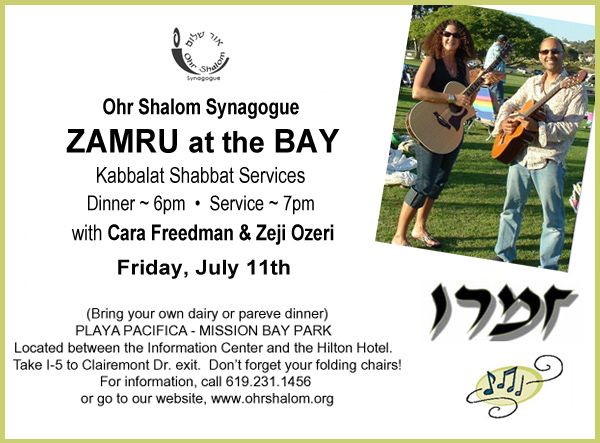

FRIDAY, JULY 18 Temple Solel Shabbat at Beach
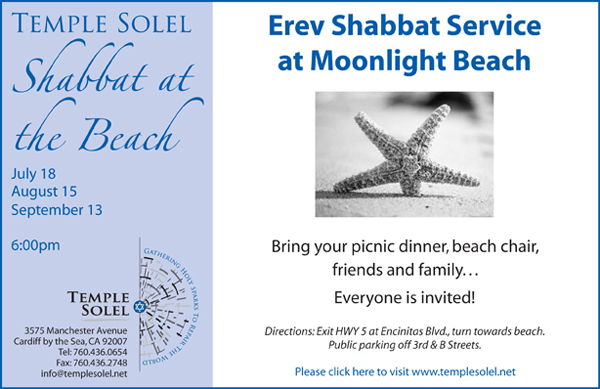

MON., SEPT. 29-THURS., OCT. 9


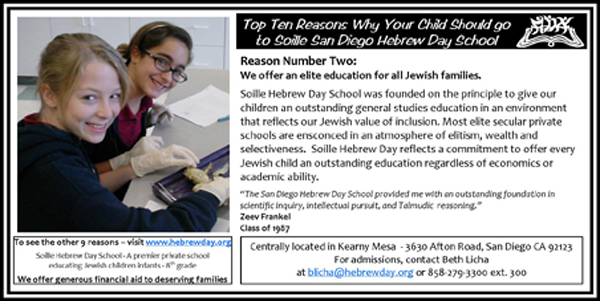

THE VIEW FROM JINSA
The cause of freedom, then and now
By Shoshana Bryen
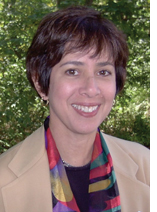 WASHINGTON, D.C.—Thirty-two years ago last week, Israel stunned the world by flying four C-130 Hercules transport aircraft to Entebbe, Uganda and rescuing hostages hijacked by the PFLP and its German accomplices. Chaim Herzog wrote, "We have demonstrated... that dignity of man, human life and human freedom constitute the highest values. We are proud not only because we have saved the lives of over a hundred innocent people... but because of the significance of our act for the cause of human freedom." WASHINGTON, D.C.—Thirty-two years ago last week, Israel stunned the world by flying four C-130 Hercules transport aircraft to Entebbe, Uganda and rescuing hostages hijacked by the PFLP and its German accomplices. Chaim Herzog wrote, "We have demonstrated... that dignity of man, human life and human freedom constitute the highest values. We are proud not only because we have saved the lives of over a hundred innocent people... but because of the significance of our act for the cause of human freedom."
Last week, the Colombian government took up the cause of human freedom, executing a daring plan to infiltrate the notorious FARC terrorist organization and rescue 15 hostages, some taken as long as six years ago. The government tried negotiations with the FARC, including releasing prisoners, but refused to grant it territory in which to operate independently. President Bush properly and enthusiastically saluted President Uribe and the Colombian military. We note also that U.S. military training and equipment were instrumental in creating a capable Colombian counterterrorism force loyal to the democratic government. [Assignment: Compare with U.S. military training to the increasingly competent Iraqi Army; and contrast with U.S. military training for the militias of the Palestinian "government."]
Also in the cause of human freedom, kudos to the United States and Iraqi militaries for secretly securing and transporting to Canada 550 metric tons of yellowcake uranium on 37 military flights in 3,500 secure barrels. No, this is not a new cache - the UN knew about it long ago, but had been unable to move it from the region. No, this is not a weapon, not even a "dirty bomb" - but enriched to higher levels, it could become one. The Associated Press reports also that earlier this year, four devices for controlled radiation exposure were removed from Iraq. According to AP, the devices contain elements of high radioactivity that could potentially be used in a weapon.
Had Saddam succeeded in wearing out the UN and ending the sanctions regime, or had the United States withdrawn from Iraq when Nancy Pelosi and Harry Reid were convinced we were losing the war, the yellowcake and the radiation devices would both have remained in Iraq for Iran and/or al Qaeda. Instead, Iraqi yellowcake will be secured in the West and the radiation devices returned to the manufacturer, joining the Libyan nuclear material stored at Oak Ridge, TN as a counter-proliferation success.
It was a very good week's work by Colombia, Iraq and the United States.
Sad, then, that this week - 32 years after Entebbe - Israel will hand over Samir Kuntar, whose claim to infamy is that he smashed a little girl's head into a rock with a rifle butt after killing her father. He goes to a hero's welcome in Lebanon in exchange for the bodies of two kidnapped IDF soldiers. While Hezbollah celebrates, Israel will mourn and Gilad Shalit will remain a hostage in Gaza. Knowing now that Israel will release killers for hostages, Hamas announced it would increase its ransom demand for Shalit to include bigger, bloodier terrorist fish, and the IDF is preparing for more kidnapping attempts by enemies along its borders.
The cause of human freedom - particularly that of Gilad Shalit - didn't do well everywhere.




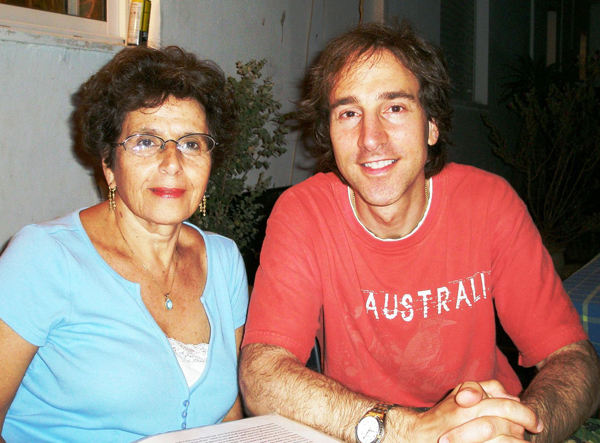
FROM THE GATES OF THE NEGEV
Volunteers psychologically counsel people, repair houses in rocket-scarred region
By Ulla Hadar
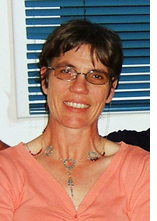 KIBBUTZ RUHAMA, Israel—There is a guesthouse at our kibbutz and this week I met two Jewish visitors from New York who had come for a 14-day stay. Their purpose was to provide volunteer service to Sderot and its neighboring areas. KIBBUTZ RUHAMA, Israel—There is a guesthouse at our kibbutz and this week I met two Jewish visitors from New York who had come for a 14-day stay. Their purpose was to provide volunteer service to Sderot and its neighboring areas.
I invited the two of them for a chat on my outdoor patio so I could learn about their motivation for their trip to Israel. Dr. Sheila Salama, born in Cairo, Egypt, emigrated when she was 15 years old for Europe, along with many other Jewish Cairenes. After living two years in Paris she arrived as a refugee to New York City. Today the Cairo Jewish population is scattered all over the world.
Dr. Salama is a specialist in adult and child psychiatry. Over the years she developed six methods to treat trauma patients, some of them possible even if patient and doctor can not speak much of each other's language.
Her attachment to Israel became increasingly stronger over the years. This is her fifth visit to our country. She joined AIPAC (American Israeli Public Affairs Committee) together with her 20-year partner Sam Schnapp three years ago. Following their stay in the Sha'ar Hanegev area, they will rendezvous with the AIPAC delegation from New York for meetings and discussions with Israelis journalists, politicians and defense forces.
They chose the Sderot area as a venue for volunteer work after watching video clips about the situation resulting from the rockets fired from Gaza. They said the situation saddened them and that they wanted to support the people in this southern battle area.
Schnapp explained: "Israel has always been a big part of my family, something that I myself always believed very important. At the age of 7, I visited Israel for the first time. It was my brother's bar mitzvah. Next time was at the age of 16 with a group of teenagers. In college I had to learn a language, so what was more natural for me than to choose Hebrew? I then took summer courses at the Hebrew University in 1983. These visits strengthened my feelings for Israel and they got even stronger over the years. In the late 90's I was following the debate around the peace process and studied the developments very closely. The bonds that connect me to Israel are through friends of mine that did aliyah and family living in Kibbutz Matzuba near Nahariya."
He continued: "In 2002 I had an urge to come to visit everyone I know because when you watch the news it seemed so unbelievable that people continue to live here. But as you visit you see for yourself that life goes on and the country continues to manage and function. For the last two years I have been connected to Sarel (volunteers for Israel). I have had wonderful experiences with this organization doing volunteer work especially following the Lebanese War, as part of a group of twelve.
"This time I was to join a group from Sarel to do volunteer work in Sderot but at the last moment it was cancelled because of language barrier and security issues. Sheila and I decided to come anyway and try to find some places where our help would be needed."
The couple performed different volunteer tasks in the two weeks they spent here. Salama treated a lot of people in Sderot suffering from different traumatic experiences while Schnapp has repaired and painted houses damaged by rocket attacks.
Schnapp concluded :" I feel we have to send a different kind of signal to the people still living in Sderot, no matter what they have have to go through— to show them that there are people in the world that care and want to help."


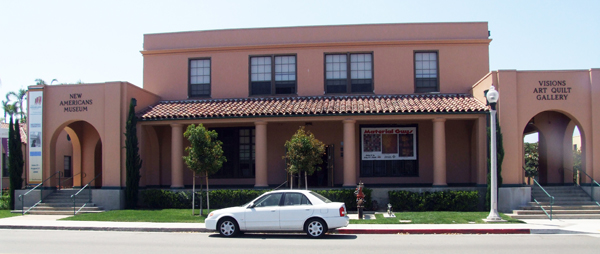
THE JEWISH CITIZEN
New Americans Museum celebrates
some of this country's richest blessings
By Donald H. Harrison
 SAN DIEGO—When my friend Dan Schaffer and I set out to visit the recently-opened New Americans Museum in the Liberty Station area of San Diego, we thought we were going to visit just one museum. As it turned out, we visited three museums all occupying the same large building. What was remarkable was that the three experiences—plus a side trip to a new restaurant—all were interrelated. They all reflected how rich America has become because it is a land of immigrants. SAN DIEGO—When my friend Dan Schaffer and I set out to visit the recently-opened New Americans Museum in the Liberty Station area of San Diego, we thought we were going to visit just one museum. As it turned out, we visited three museums all occupying the same large building. What was remarkable was that the three experiences—plus a side trip to a new restaurant—all were interrelated. They all reflected how rich America has become because it is a land of immigrants.
The 4,000-square-foot New Americans Museum is the brainchild of Deborah Szekely, perhaps best known internationally as the founder of the Golden Door spas and the Rancho La Puerta health resort of Tecate, Mexico. The daughter of Jewish immigrant parents, Harry Shainman (also spelled Szainman) of Warsaw and the former Rebecca Sudman of Austria, Szekely was raised in the Far Rockaway Beach area of Brooklyn, near Coney Island, with the sound of her mother’s German and father’s Yiddish in her ears. Szekely also learned English as a child.
Her parents’ marriage was of the Only-in-America type, her father having immigrated steerage class to America to avoid being conscripted as a poor youngster into what was then the Russian Army. Her mother, the child of wealthy fur traders, steamed in elegance to America’s shores. Not one to put on airs, Rebecca worked as a nurse in New York, eventually meeting Harry. When the Depression came, Rebecca, able to draw on her parents’ resources, prevailed on her husband to relocate the family to Tahiti.
Many years later, after returning to the United States and making her success in the spa movement, Szekely became president of the Inter-American Foundation, traveling extensively throughout the Western Hemisphere. During a telephone interview, she told me that it was the stories that she encountered in this U.S. diplomatic assignment—rather than her own immigrant background—that motivated her to create the non-profit New American Museum.
“Every place I went, whether the Caribbean or Latin America, I was chatting with the women,” she recalled. “They would point out their young kids, bright, and say ‘that is the one that we are going to send to America.’ People don’t realize that the children were these families’ investments in the future--like venture capitalists. The best of the best of the family is sent to America, and everyone in the family chips in… whether from Latin America, South Africa or Cambodia. And the kids repay their families’ investments with their successes.”
For example, said Szekely, Mexican immigrants to the United States send billions of dollars per year in remittances to their families. “They hold two jobs, one to repay the investments of their families to bring them here,” she said. As strong as the sense of gratitude is in the first generation of immigrnts, it typically diminishes in the second generation, Szekely said. “The kids don’t send as much money back as the parents, who feel the obligation.”
There are benefits and drawbacks to such patterns of immigration, the museum founder said. “They come here full of high hopes and get treated as second-class citizens. Not speaking English doesn’t mean that you are not bright. How many of us (Americans) can speak Spanish? But people see things out of context. None of the kids came here because they were looking for a free ride.”
Referring to portraits now on exhibit of teenage immigrant children photographed for the Smithsonian Institution by Barbara Beirne—in which the subjects wrote their own captions—Szekely said: “Look at these kids: We are truly getting the best of the best, and this has to be recognized!”
In the exhibition, youngsters from throughout the world tell of their families’ reasons for coming to America. In many cases, it was to avoid warfare or political persecution in their countries of origin. In others, as alluded to by Szekely, they came because of the economic opportunity that America represented. Some of the youngsters also told of the adjustments their new lives’ required.
Szekely said it is unfortunate that immigrant children sometimes don’t realize how bright, and far-seeing, their parents have been. “Sometimes, the parents are looked down upon because they are poor. The children think if they are poor, they are not bright.”
The mistake the children make is to confuse material advantages with intellect. The parents may, in fact, be very bright, even if “they came from a place where they did their washing in a river, whereas now they have a washing machine, which they think is wonderful, or if the father is a gardener, who thinks it is wonderful to have his own truck and tools,” Szekely said. “Some kids think their parents don’t have the capacity, or the potential, and they do.”
The problem, she suggested, is that “stereotypes have been sold to the kids.” The New American Museum, even while in formation, fought against stereotypes. It sponsored essay contests in which immigrant children were encouraged to interview their parents about their lives in the old country and the circumstances of their immigration. “The kids have been astonished when they ask what their parents what it was like, and there has been a whole new bonding.”
Photographer Bierne said her project was inspired in 1999 by meeting teenage refugees from Kosovo, and deciding to seek teens from other countries. “I searched for places to meet these newcomers in the hope of being able to photograph them in their new surroundings. My first stop was Grand Street Settlement in New York City, a non-profit organization that has provided services to immigrants since 1916…” She offered the teenagers autonomy in selecting where to be photographed, what they would wear, and “the messages that would accompany the photographs.” She then traveled throughout the United States from 2000 to 2006 meeting immigrants, refugees and American-born children of immigrant parents.
As Dan and I read the teenagers’ comments, we could not help but remember the immigrant generations of our respective families. In my case, my paternal great grandparents arrived approximately in the 1880s from Rzezow in what is now Poland (then Austria-Hungary), and my maternal grandparents arrived early in the 1900s from Lithuania. Dan’s parents were of a similar Eastern European background; his mother, the former Norma Diamond, was from Poland, and his father, Maurice, hailed from Lithuania. They met in Cleveland, where they were married in 1921.
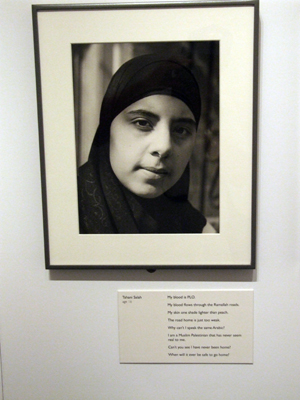 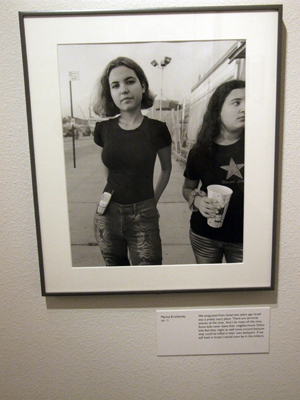
Both of us were particularly interested in the comments of teenagers from Israel and of Palestinian background that reflected the hurt on both sides of the conflict. Tahani Salah, 16, wrote under her photo: “My blood is P.L.O. My blood flows through the Ramallah roads. My skin one shade lighter than peach. The road home is just too weak. Why can’t I speak the same Arabic? I’m a Muslim Palestinian that has never seemed real to me. Can’t you see I have never been home. When will it ever be safe to go home?”
In contrast, Marina Krichevsky, 16, wrote: “We immigrated from Israel two years ago. Israel was a pretty scary place. There are terrorist attacks all the time and I do mean all the time. Some kids never leave their neighborhood. Other kids feel they might a well move around because they could be killed in their own backyard. If we still lived in Israel I would be in the military.”
A second exhibit was locally produced: “Contemporary Story: Perspectives by Immigrant and Refugee Artists,” in which refugee teens studying photography made studies of the lives and works of other immigrants involved in both the performing and creative arts.” In most cases, the subjects were from different countries than the photographers.
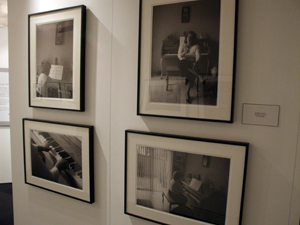 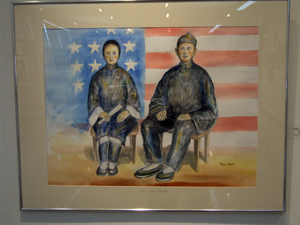
A four-photo study was of classical piano teacher Yevgenia Nisman from Odessa, Ukraine, as seen by Ahmed (Last Name not given), 18, from Somalia. There were two different views of Nisman playing her piano; another, closer up, of her sitting at the piano, and finally, a study of her hands on the keys. Nisman is a member of our Jewish community.
The museum describes its mission as being “a catalyst to celebrate America’s past and promise” and providing “inspiring and compelling educational and cultural programs and activities of our diverse immigrant experience.”
The executive director of the museum is Gayle Hom, a third-generation Chinese American whose father, Tom Hom, once served on the San Diego City Council and later represented San Diego in the California State Assembly. Her late mother, Dorothy, was deeply involved in the creation of the Asian Pacific Thematic District in downtown San Diego.
Hom is married to a Jewish man, Sheldon Zemen. Their wedding incorporated Jewish and Chinese customs. Hom became a Jew-by-choice and both their children have become bar and bat mitzvah at Congregation Beth Am. Her story resonated with me because my own son David and his wife, Hui-Wen, similarly had a wedding that encompassed both their rich heritages.
An interesting side note about the museum is that its location at 2825 Dewey Road in “Liberty Station,” as the former Naval Training Center is now named, sits in the Roseville section of the Point Loma neighborhood of San Diego. Roseville was the town site laid out in 1869 by Louis Rose, the first Jewish settler in San Diego. As Rose was an immigrant from Neuhaus-an-der-Oste, Germany, it turns out that the museum honoring immigrants is itself located in an area laid out by an immigrant.
After visiting the New American Museum, Dan and I walked a few paces into the gallery operated by the San Diego Watercolor Society, which offers a new exhibit the first Friday of every month. The current one, in celebration of the opening of its neighboring New American Museum, is patriotically themed “red, white and blue and all the other colors too,” according to the society’s former president, Risë Parberry, who like other board members volunteers as a docent.
“1850… New Roots,” (pictured above) is an eye-catching painting depicting two Chinese in traditional dress against a background of the American flag. The painting is the work of Tom Hom, father of Gayle Hom.
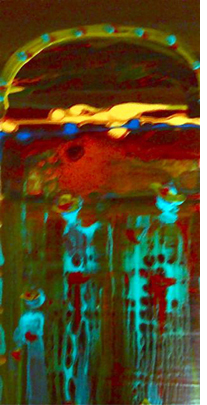 Another work that drew my attention was “Entrance to the Garden of Eden” (at left) an abstract by Rachel Hasson utilizing acrylic paint on a Japanese plastic material known as yupo. Hasson had been born in Lvov, Poland, and avoided the Holocaust by immigrating to Palestine in 1939. She later studied medicine in the United States, becoming a professor of pathology and pediatrics at Albert Einstein College of Medicine in New York. She took up painting in her retirement. Besides her work on display in San Diego, she currently has a one-woman show in the community of Laguna Woods, where she now resides. Another work that drew my attention was “Entrance to the Garden of Eden” (at left) an abstract by Rachel Hasson utilizing acrylic paint on a Japanese plastic material known as yupo. Hasson had been born in Lvov, Poland, and avoided the Holocaust by immigrating to Palestine in 1939. She later studied medicine in the United States, becoming a professor of pathology and pediatrics at Albert Einstein College of Medicine in New York. She took up painting in her retirement. Besides her work on display in San Diego, she currently has a one-woman show in the community of Laguna Woods, where she now resides.
Located on another end of the building is the Visions Art Quilt Gallery, where a touring exhibit cleverly called “Material Men” (a pun on Madonna’s signature song “Material Girl”) shows the works of male quilters. One of the volunteers at the gallery was Boatema Boateng (the ‘o’s in names are pronounced like ‘w’s), an expatriate from Ghana who is an assistant professor of communications at UCSD. Dan, who once had served as a teacher in Nigeria before settling down to a long career as a high school teacher in San Diego County, conversed with her about pedagogical styles and educational techniques in the United States and in West Africa.
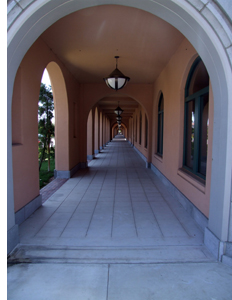 Eventually, Dan and I left the museum building to continue our tour of Liberty Station, an area that may well become another great cultural center of San Diego similar to Balboa Park. We wandered through a long arched walkway, soon finding Tender Greens, a new restaurant emphasizing local organic foods, which co-owner Rian Brandenburg (a former chef at the Lodge at Torrey Pines) told us is intended to bring cuisine that is both healthy and imaginative to casual diners. The young woman who seated us for a very tasty lunch was Dasha Bondurovska, a recent immigrant from Ukraine. Another member of the staff is Rachel Roos, a new arrival from Brazil. Eventually, Dan and I left the museum building to continue our tour of Liberty Station, an area that may well become another great cultural center of San Diego similar to Balboa Park. We wandered through a long arched walkway, soon finding Tender Greens, a new restaurant emphasizing local organic foods, which co-owner Rian Brandenburg (a former chef at the Lodge at Torrey Pines) told us is intended to bring cuisine that is both healthy and imaginative to casual diners. The young woman who seated us for a very tasty lunch was Dasha Bondurovska, a recent immigrant from Ukraine. Another member of the staff is Rachel Roos, a new arrival from Brazil.
Wherever we went that day, Dan and I encountered “New Americans” who are enriching our country’s cultural and economic lives. How apropos that we should now have a museum to celebrate our nation’s good fortune.
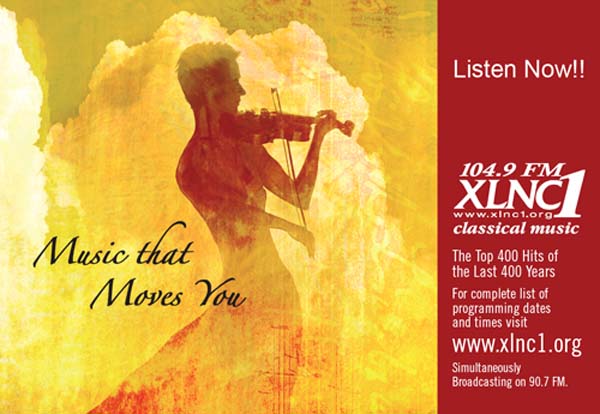

REFLECTIONS
Two Yiddish books to tickle the silly bone
By Sheila Oryseik
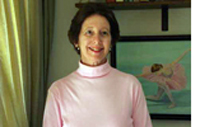 SAN DIEGO—Yiddish for Dog & Cat Lovers by Marjorie Gottlieb Wolfe, (Malka Publications - 2007; ISBN: 9780615167992; $13) is a soft bound book of 129 pages bringing together humor, language and animal lovers. Each page has either a photo or a cartoon (by artist Earl Engleman) captioned with a short saying or bon mot in Yiddish with an English translation. Or a reasonable facsimile thereof. SAN DIEGO—Yiddish for Dog & Cat Lovers by Marjorie Gottlieb Wolfe, (Malka Publications - 2007; ISBN: 9780615167992; $13) is a soft bound book of 129 pages bringing together humor, language and animal lovers. Each page has either a photo or a cartoon (by artist Earl Engleman) captioned with a short saying or bon mot in Yiddish with an English translation. Or a reasonable facsimile thereof.
Since I have been trying to recapture the Yiddish of my youth, it was fun to try to translate the caption and then check it with the English translation. Sometimes a direct translation works, but most of the time the particular sense of a proverb or bon mot doesn’t quite make it directly across the literal language barrier. Never mind - it was still fun. The glossary at the end of the book is a bit of icing on the cheery cake. Nempt a hunt un gehb a kook arein. (Grab a dog and give a look inside.)
Wolfe’s Yiddish Trivia (Malka Publications - 2004) is 111 pages, small soft bound book. It is page after page of all the trivia a Yiddish lover can handle and then some. Obviously, a great deal of time must have been spent gathering all these luckshen vaygen der mama loshen (noodles about the mother language) into a kugel of a book.
The entries fall into general types though not arranged in any order that was obvious to me. Some samples:
Informative: Over 50 universities teach Yiddish. (Whether as a spoken language or part of a culture, is not made clear. But it is interesting anyway - who would have thought?)
Handy: A website which offers a “klutz-proof” Sukkah kit. (Spell check didn’t flag “klutz.”)
Travel Tip: The “Chopped Liver River Band” (gehakte leber) is based in Lancaster, Pennsylvania. (No mention is made if they are kosher.)
Extraneous: Adam Sandler has a bulldog named “Matzo Ball.” (I have no idea who he is - but if I run into his dog, I’ll put him back in the soup.)
Food: There are two words for potato in Yiddish: “bulve and kartofl.” (But in both cases, I assume, if you fry them - it’ll come out latkes. Spell check didn’t flag “latkes” either.)
Questionable: A “teppel” is the Yiddish word for “bowl” or “ladle.” (Well, not according to my two dictionaries. “Bowl” is “shissel.” One dictionary says “teppel” means “cup.” When my bubba said “teppel” - she meant “pot.” And neither dictionary had an entry for “ladle.” But, Yiddish dictionary online calls a ladle “kochlafel” a cooking spoon and a pot “tup.”)
A one liner: In Israel they just say “motzetz.” Ex: “Gib mir de motzetz.” (Huh? What do I do with this information?)
Puzzling: “Moyl” is another acceptable spelling for the word “mouth.” (Okay)
And finally - the coup de gras (for me): A “trombenik” is a bum, a loudmouth, a ne’er do well (slang). In Yinglish, a “trombenik” is a “blufferken.” (There is no way I can use this information.)
The entries seem random, and while there is a glossary in the back, there is no index to locate anything in particular. But maybe that’s a trivial quibble. If you like trivia - from the interesting to the truly trivial - this book is for you.
Abi gezunt. (As long as you are healthy.)
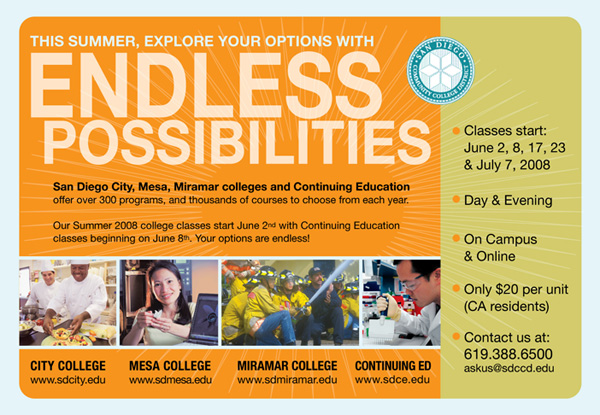

ADVENTURES IN SAN DIEGO JEWISH HISTORY
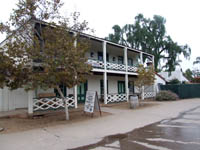
Robinson-Rose House
|
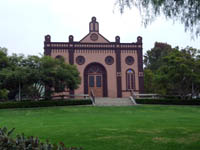
Old Temple Beth Israel |
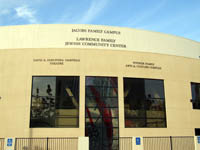
Lawrence Family JCC |
Editor's Note: We are reprinting news articles that appeared in back issues of various San Diego Jewish newspapers. You may access an index of the headlines of those articles by clicking here. You may also use the Google search program on our home page or on the headline index page to search for keywords or names.
Palomar Camp Will Be Site Of Outdoor Activities
From Southwestern Jewish Press, July 3, 1947, page 1
Word has just been given the United Jewish Fund’s Community Center Committee that Palomar Camp in the mountains will be the site of the one week camp being sponsored in conjunction with the Day Camp.
The Committee announced that it would operate Camp Palomar from Monday, July 28 through Sunday, August 3—a full week of camping away from home. Activities planned at the camp will include hikes, nature study, camp craft, fishing, games, song fests, camp fires and many others, including a trip to the Palomar Observatory.
The fee for the one week at the camp, based on actual cost of the camp, will be $25.00. This will include all facilities and transportation to and from Camp Palomar.
Staff will consist of several of the Counselors now working with the day Camp and counselors provided by the City and County Commission. The Committee will also seek several volunteers to act as counselors.
“Camperships” are available to those who are unable to pay the full tuition. For any information regarding them call Albert Hutler at F-0171.
Registration for Camp Palomar will open on Monday, July 7. It is suggested that those who wish to register their children do so at once since the number that can be taken is limited. Camp will be for children between the ages of 7 to 14, both boys and girls. For registration, call Franklin-0171. The camp will be under the active direction of Albert A. Hutler, Executive Director of the United Jewish Fund.
Representatives of Agencies Meet in Temple
From Southwestern Jewish Press, July 3, 1947, page 1
In the first meeting of its kind in San Diego, and one of the first in the country, local and national representatives of various agencies met Sunday morning in Temple Center to present their requests to the Budget and Allocations Committee of the United Jewish Fund of San Diego.
Sixteen committee members were assembled when Chairman Victor Schulman opened the meeting at 10:100 a.m. The representatives of the twelve organizations that presented their needs first outlined briefly their organization’s history and record of service, and named the 1946 amounts before making their 1947 requests.
The more than $200,000 that San Diego raised so far this year is not sufficient to meet the budgets presented and as the value of each agency’s work is realized, the committee will vote as best they can to meet the various requests.
The San Diego United Jewish Fund has voted to continue the 1947 drive to try to raise the original quota which was $350,000. Albert A. Hutler, executive director of the Fund, stressed the need for all subscribers to pay their pledges now so that these monies will be on hand to meet the various requests. Its is further urged that anyone who hasn’t made a contribution to this most necessary Fund so far, please o so without further delay.
Day Camp is Popular For Many Children
From Southwestern Jewish Press, July 3, 1947, page 4
Children playing tag with the water at the beach; little five and six year olds learning to ride a horse; girls and boys using their imagination modeling clay figures, drawing pictures of what they see; children singing as they ride to Torrey Pines for fun on the beach, hiking in the park; mouths of little children open in amazement at the story being told to them by their counselor. These and other activities graphically illustrate the day Camp being sponsored by the Community Center Committee of the United Jewish Fund.
Forty children both Christian and Jewish are learning to live together and to play together under the direction of competent counselors. They are following a well planned program which is being closely watched by all recreational agencies in the San Diego area. The Day Camp may well be a demonstration of what can be done for every child in the San Diego community. The Day Camp program for this week was as follows: Monday-physical examination, nature hike, archery, games and songs; Tuesday-Torrey Pine day for swimming, hiking and cookout; Wednesday—an exciting trip to a naval carrier anchored in the bay, an afternoon on the beach at Coronado; Thursday—a great big day for every child at the County Fair; Friday, July 4, no camp.
The coming week program will include a nature hike, games in Pepper Grove and arts and crafts on Monday; Tuesday the children will as usual travel to Torrey Pines; Wednesday they will tour the Marine Base; Thursday clay modeling, arts and crafts, swimming lesson at Mission Beach Pool; and Friday riding lesson at Balboa Stables, arts and crafts, games and services at the Temple to complete the week.
Registration in the Day Camp now totals 40 children with another six who will join the group during the camping season. Further registrations are being accepted and placed on the waiting list.
San Diego Prepares For Post-USO
From Southwestern Jewish Press, July 3, 1947, page 4
The USO Area Staff and the community Welfare Council of san Diego sponsored a joint conference Friday, June 27th, for the purpose of formulating plans for continuing certain USO programs and values when USO finally terminates on December 26th. The morning session, which was held at the Army and Navy YMCA, had for its main topic “The ‘Kid Brother’ in Uniform. The discussion period was led by Mrs. Louise Cochran, National USO Program Consultant. The meeting was well attended by representatives of the military and the community. A luncheon meeting was held at the San Diego Hotel, with Mrs. Cochran as the speaker. She discussed “Focusing the Spotlight on Community Responsibilities to Servicemen.”
Mr. George Scott, as chairman, outlined some of the plans San Diego should consider. Towards this end, a special committee for Services to Servicemen has been appointed by the Community Welfare Council to work towards perfecting a permanent community organization. Mrs. Burt F. Raynes is chairman of this committee.
Rabbi Morton J. Cohn, Mrs. Rose Neumann, Mrs. Ray Solomon and Al Hutler attended the luncheon. Esther Siegel, local JWB Director, was chairman of the USO Planning Committee.

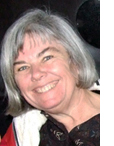 Nancy Harrison Nancy Harrison
cruise & tour specialist
(619) 265-0808

SAN DIEGO JEWISH WORLD THE WEEK IN REVIEW
Middle East
—Stopping Iran's growing nuclear threat by U.S Congressman Bob Filner in San Diego
Environmentalism
—Sometimes 'brown' is better than 'green' by Sheila Orysiek in San Diego
San Diego
Governor Grille, a kosher meat restaurant, makes its debut at Chabad-University City by Donald H. Harrison in San Diego
Adventures in San Diego Jewish History
—June 26, 1947: Birdie Stodel B.B.
—June 26, 1947: Pioneer Women
—June 26, 1947: Jewish Labor Com.
—June 26, 1947: Jolly Sixteen
Arts
The Joker: from Catskills to Gotham City by Rabbi Simcha Weinstein in New York
Rose burdened with too many thorns by Cynthia Citron in Los Angeles
Middle East
Peres: Peace with Palestinians not possible by Ira Sharkansky in Jerusalem
Judaism
The joy and enthusiasm of new Jews by Rabbi Leonard Rosenthal
The Chofetz Chaim and the Russian soldier by Rabbi Baruch Lederman
Adventures in San Diego Jewish History
—June 26, 1947: Living Memorials For the Dead {Editorial}
—June 26, 1947: Lasker Lodge B.B.
—June 26, 1947: Day Camp's First Week Big Success
Sports
July 4th baseball: Thunder in skies, also in the stands at Storm game in Lake Elsinore by Donald H. Harrison in Lake Elsinore, California
A bissel sports trivia with Bruce Lowitt in Clearwater, Florida
Middle East
Few parallels between U.S. operations in Afghanistan, Iraq and Israel-Palestine by Ira Sharkansky in Jerusalem
California and San Diego
What does the state budget proposal say about California's moral compass? by Gary Rotto in San Diego
How do you spell tikkun olam? G-R-E-E-N by Donald H. Harrison in San Diego
San Diego Jewish Trivia: Movies by Evelyn Kooperman in San Diego
Adventures in San Diego Jewish History
—June 19, 1947: Yo-Ma-Co
—June 19, 1947: Birdie Stodel B.B.
—June 26, 1947: Eli Levenson Elected To Executive Comm. of B'nai B'rith
—June 26, 1947: Hearings to Be Held On U.J.F. Allocations
Arts
Klezmer with knishes, juice and 'p'stromi' by Carol Davis in San Diego
Chapter Fifteen of Reluctant Martyr, a serialized book by Sheila Orysiek in San Diego
Middle East
Carnage again stalks Jerusalem's buses by Judy Lash Balint in Jerusalem
Victory in Iraq is well-worth fighting for by Shoshana Bryen in Washington, D.C.
Biking can make you and planet more fit by Ulla Hadar in Kibbutz Ruhama, Israel
United States of America
American Jewish civics quiz for July 4 by Sheila Orysiek in San Diego
San Diego
Confronting abuse in the Jewish community by Rabbi Jeff Brown in Cardiff by the Sea, California
Adventures in San Diego Jewish History
—June 19, 1947: Hashomer Hatzair to Have Summer Camp
—June 19, 1947: Program Completed for Day Camp
—June 19, 1947: Jewish War Vets
Arts
Thursdays with the songs of Hal Wingard
—#247, Dieting
—# 308, Great New Diet
—# 74, Bad Booze Blues
Middle East
'Standupistim'—That's Hebrew for 'Stand Up comics'—wow 'em in Israel by Judy Lash Balint in Jerusalem
Only in Israel? A Tale of Four Chickens by Dorothea Shefer-Vanson in Mevasseret Zion, Israel
Australia
The Jews Down Under, Jewish news of Australia and New Zealand by Garry Fabian
Progessive view on Rabbi Jonathan Sacks ... Historic agreement on emergency management ...Graeme Samuel explains silence on Pratt case ... Being 'green' is the Jewish thing to do .. Salary hikes impact on Jewish school ... New Zealand's Jewish Community doubly celebrates ...
Australia -Israel link on celluloid...Antisemitism after the Holocaust
San Diego
The 20-gallon challenge; can you save water each day, help preserve Earth's resources? by Donald H. Harrison in San Diego
Adventures in San Diego Jewish History
—June 19, 1947: U.J.F. Campaign Continues
—June 19, 1947: Newcomers to Country Welcome Baby Boy
—June 19, 1947: Francis W. Parker School Packs 20 Boxes for S.O.S.
—June 19, 1947: Temple Sisterhood Sponsor New Project
Lifestyles
When the extended family met at the grandparents' house in Newark, N.J. by Gail Feinstein Forman in Newark, N.J.
Middle East
Israel's painful deal with Hizbollah by Ira Sharkansky in Jerusalem
What the devil is O.C.S.? or how to end importing Middle East oil by J. Zel Lurie in Delray Beach, Florida
Canada
In aftermath of Golubchuk case, Canada grapples with when a patient is dead by Rabbi Dow Marmur in Toronto, Canada
San Diego
San Diego Mesa College librarian Jack Forman a connoisseur of Jewish books by Donald H. Harrison in San Diego
Adventures in San Diego Jewish History
—Honor Your Loved Ones On-line
—June 12, 1947: Pioneer Women
—June 12, 1947: Birdie Stodel B.B.
—June 12, 1947: J.C.S.C.
—June 12, 1947: Gerald Schissell Elected To Office
Lifestyles
Pop proudly gives a tour of his 'palace' by Gail Feinstein Forman in San Diego
Middle East
Sarkozy should butt out of Israel's affairs by Isaac Yetiv in La Jolla, California
Judaism
Midbar kvetching:complaints in the desert by Sheila Orysiek in San Diego
Adventures in San Diego Jewish History
—Honor Your Loved Ones On-line
—June 12, 1947: U.J.F. Announces Close of Campaign
—June 12, 1947: Telegram from Henry Morgenthau Jr. to Albert Hutler
—June 12, 1947: Admiral Badger Accepts Placque (sic)
The Arts
Cast of Morgan-Wixson's Cabaret weak by Cynthia Citron in Santa Monica, California
Lifestyles
Dancing their way through the senior years by Donald H. Harrison in Oceanside, California
Menus come on parchment in Dussini Mediterranean Bistro in the Gaslamp by Lynne Thrope in San Diego
Link to previous editions
< BACK TO TOP
|
|
